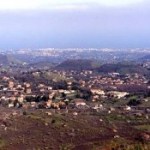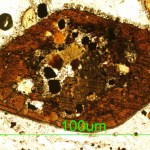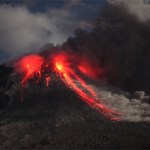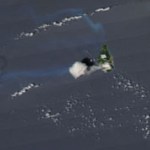pyroclastic flow
The Doctor fights off a magma creature in Pompeii.
Now, most of the time I talk about why I started this blog, I talk about the eruption of Chaiten in Chile as the catalyst. However, if you look back at my archives, you'll see that one of my first posts was on the Doctor Who episode "The Fires of Pompeii" - so that might also be a good marker to point to on why I started this blog. Why do I bring this up? Well, Pompeii gets mentioned a couple times in the first few seasons of the revived Doctor Who. First off, when the Doctor meets Capt. Jack Harkness (a time-traveling huckster), Capt. Jack…
Finally, a chance to catch up a bit ... !
Yasur erupting in May of 2010.
Some news from the world of volcanoes:
The BBC has a series of videos one the fallout from the Eyjafjallajökull eruption - including a look at the area around the volcano and how the economy has been affected by the eruption. However, things seem pretty quiet at the summit of the Eyjafjallajökull summit where snow can begun to settle without melting - and the Icelandic Met Office appears to think that the eruption is more or less (but not officially) over. And take this press release as you will, but a recent study…
The final part of Etna Week, brought to us by guest blogger Dr. Boris Behncke. Check out Part 1 and Part 2 as well!
Etna Volcanic hazards
By guest blogger Dr. Boris Behncke.
Etna is one of the most active volcanoes on Earth, and a population of nearly one million people dwell on its flanks, many in areas that have been repeatedly invaded by lava flows during the historical period. A few villages have been constructed very close to the vents of eruptions only a few hundred years old.
Top: Residential areas surrounding numerous pyroclastic cones on the lower southeast flank of Etna, seen…
Karangetang in Indonesia erupting in June of 2007.
This year we haven't had a lot of news about volcanic activity in Indonesia. This is not to say that eruptions haven't been happening, rather they just haven't been in the news. If you check out the current status of the volcanoes of Indonesia, you'll see that no less than six volcanoes are on orange (Level 2) status and another fourteen are on yellow (Level 1 - and there is a Level 0 as well). So, it is a active arc as arcs go (compare that to the Aleutians or Cascades).
This means that it should come as little surprise that Karangetang on…
A new Weekly Volcanic Activity Report from the Smithsonian and USGS Global Volcanism Program!
Highlights from this week's report include:
Things are getting a little noisy in Colombia. I mentioned a few weeks ago about a possible explosion at Nevado del Ruiz. Now we have reports of increased seismicity under nearby Cerro MachÃn and ash plumes from Nevado del Huila. After a few centuries of relative quiet, it looks like the volcanoes of the Colombian Andes are looking more lively.
Also in South America, a gas plume was spotted at Chile's Planchon-Peteroa. This is the second time this year…
So, I've had requests on the blog to help to do some defining of volcanologic terms on the blog, so I thought I'd try a new column called Eruptions Word of the Day. I'm not sure how often it will run, but let's give it a try.
Eruptions Word of the Day for July 5, 2010: Dacite
Dacite is a magma type defined by silica (SiO2) content between 63-68 (or 69) weight percent. That is the textbook definition, but some other typical characteristics of dacite lavas (or magmas) is the presence of certain minerals: plagioclase feldspar and hydrous minerals (containing water in their mineral structure)…
The latest news from the world of volcanoes, brought to us by the Global Volcanism Program, USGS and the Smithsonian Institution. They are also brought to us by Sally Kuhn Sennert - and if you have a question for her about her job at the GVP preparing the Weekly Volcanic Activity Report and all things volcanic (and hopefully it won't end like another recent volcanically-mitigated interview).
Some highlights (not including Gorely and Sakurajima):
Ioto (aka Iwojima) in the Volcano Islands of Japan produced an ash plume of unknown height. The volcano has frequent phreatic eruptions and abundant…
Ah yes, a reminder that there are other volcanoes erupting around the world than Eyjafjallajökull - but yes, it is true! Here is the latest USGS/Smithsonian Global Volcanism Program Weekly Volcanic Activity Report!
Highlights (not including Iceland) include:
Another volcano in the Kuril Islands of Russia is showing signs of, well, something. Ketoi was noticed to be experiencing increased fumarolic activity according to satellite images. Ketoi hosts a Pleistocene caldera but has had three historic eruptions over the last few centuries, most recently in 1960, and all of which were explosive…
Catching up with some news:
Anatahan erupting in the northern Mariana Islands in 2003.
I ran across this article right before I got sick, but its been popping up around the interwebs (and is pretty interesting). It details a study in Molecular Ecology that suggests that populations of caribou in Canada's Yukon Territory were strongly effected by the White River Tephra. The White River Tephra is supposedly the largest Holocene plinian tephra (from a ash cloud fallout), with two components dating from ~1900 years ago and ~1250 years ago. The vent for the WRT is likely from a vent beneath the…
Not a lot of big news, but a lot of little news:
Soufriere Hills at night during the late January 2010 dome growth episode. Note the hot rock falls from the collapsing dome. Image courtesy of Photovolcanica.
This might not be new, but Dr. Boris Behncke brought the new webcam at the rim of Chaiten in Chile to my attention. You get a birds-eye view of the growing dome from the edge of the caldera - pretty nifty view for a once-in-a-hundred-years sort of event.
The NASA Earth Observatory has posted a close-up of the Soufriere Hills imagethat I posted yesterday, showing the February 11 plume.…
Two impressive eruptions going on right now:
Soufriere Hills erupting on February 11, 2010. Image courtesy of the Montserrat Volcano Observatory.
Soufriere Hills just keeps on raising the bar during its new eruptive period. The volcano on Montserrat in the West Indies produced a 15 km / ~45 000 foot ash plume as the summit dome partially collapsed again. It was one of the biggest volcanic events at Soufriere Hills in the last 15 years, with 10-15% of the dome collapsing. One of the regional airlines in the West Indies have had to cancel flights due to the ash that has mainly been heading to…
A pyroclastic flow from the February 5 vulcanian eruption of Soufriere Hills. Image courtesy of the Montserrat Volcano Observatory (MVO).
UPDATE: See some amazing images of the recent eruptive activity over on Stromboli Online. {Hat tip to the Volcanism Blog via Eruptions reader CK.}
One event that didn't eat much coverage over the weekend, at least here in the U.S., was the large eruption and explosions at Soufriere Hills on Montserrat. The volcano has had a resurgent winter since have a quiet summer of 2009. This weekend's eruption produced an ash plume that reached ~6.1 km / 20,000 feet…
The weekly volcano report, brought to you by our friends at the Smithsonian Global Volcanism Program and the U.S. Geological Survey.
Highlights (not including Mayon, Nyamuragira and Turrialba):
Eruptions continue at Piton de la Fournaise on Reunion Island - heck, this would be the volcano news if it wasn't for all these other, more explosive systems getting in the way. Lava fountains, flows and pools were the order of the day in the SW Dolomieu crater until the 12th of January.
Chaiten in Chile continues to chug along - block-and-ash flows were seen and ash plumes continue to emanate from…
Lava flows from Mayon, taken December 23, 2009.
Volcano news over the holidays this year is still focused on Mayon in the Philippines. We're reaching almost a month since the volcano starting showing signs of a major eruption, but no "big one" yet. Lava flows, ash and block-and-ash flows are continuing to be issued from the new dome at the summit, but earthquakes are down some - which is leading to the problem that people are thinking the volcano is "safe". Many evacuees are returning home already, even with the threat-level at Mayon is unchanged.
This danger of people losing faith/not…
Lava on Mayon, December 2009, with Legazpi City in the foreground.
The mainstream media has picked up on the activity at Mayon - I've seen it splashed across CNN, FoxNews, ABC, BBC and others. Most of the coverage has been decent, however, I do worry when I see that people have found Eruptions using search terms like "Mayon supervolcano". I think that is when we worry that the made-for-TV word like "supervolcano" has gotten a little overused, when people worry every volcanic eruption might be a "supervolcano."
On to the update!
Explosions have continued unabated at Mayon, with the explosive…
It's the last week of classes and it's also AGU (which I will be missing for the first time in 5 years). If you happen to be at the big meeting in SF and hear something you think we'd like to hear, feel free to drop me a line or leave a comment so we can live vicariously through you.
Pyroclastic flows at Sourfriere Hills, December 2009. Image courtesy of MVO.
Some news:
UPDATE 12:40PM 12/14/2009: Just to update the Mayon news from earlier today, PHIVOLC is reporting that lava has been spotting flowing from the main crater on Mayon. Sounds like the eruption we've been waiting for is…
Back to work after Thanksgiving Break ... lets clean up a few news items I missed trying to figure out the non-eruption of Karkar.
Undated photo of the summit area of Gaua, Vanuatu.
There was an actual eruption - or, more correctly, a continued eruption - of Gaua in Vanuatu. The current activity has prompted the evacuation of 300 villagers from the island and they will not be able to return until activity wanes. Tourists were also told to stay away from the volcano, but the airport on the island has not been affected by the eruption, which might suggest the activity is relatively localized…
The latest of volcano news from around the world, brought to you by the USGS and Smithsonian Institute Global Volcanism Program (and especially Sally Kuhn Sennert!)
Highlights this week include:
Karangetang in Indonesia produced a couple 3 km/10,000 foot steam-and-ash plumes according to reports from pilots.
Soufriere Hills on the island on Montserrat has had quite a few pyroclastic flows over the last few weeks since the volcano started erupting again. Mix that with some heavy rainfall and lahars were produced as well.
The alert level is still at Orange at Karymsky in Kamchatka, which…
Sometimes it is hard to keep up with the mountain of remote sensing (or not so remote) images that get released on the internet. Over the last few days, the NASA Earth Observatory has released a bunch of images/videos of current eruptions, so I thought I'd round them all up here for you to peruse.
Soufriere Hills releasing puffs of ash-and-steam on October 6, 2009. Image courtesy of the NASA Earth Observatory.
Four new images in the recent past:
A nice, clear picture of an ash-and-steam plume from Rabaul in PNG was captured by the Terra satellite's MODIS imager on September 30, 2009. The…
I missed the weekly report last week (sorry), but here is the new USGS/SI volcano activity report.
Highlights include:
Shiveluch in Kamchatka is still erupting away, producing ~7 km / 20,000 foot ash columns as the lava dome grows. There has also been pyroclastic flows spotted emanating from the new lava dome.
There was a report of a ~7.5 km / 25,000 foot ash-and-steam plume from El Reventador in Ecuador.
More small plumes and incandescent lava bombs were spotted at the Tavurvur Crater at Rabaul in Papau New Guinea



